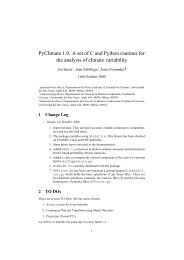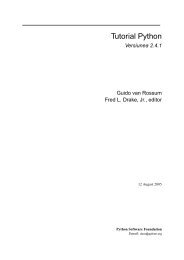PyClimate 1.1. A set of C and Python routines for the ... - Starship
PyClimate 1.1. A set of C and Python routines for the ... - Starship
PyClimate 1.1. A set of C and Python routines for the ... - Starship
You also want an ePaper? Increase the reach of your titles
YUMPU automatically turns print PDFs into web optimized ePapers that Google loves.
3.1) It raises TypeError if edata or gdata is not a 1-D NumPy array It raisesMemoryError if it is unable to allocate <strong>the</strong> returned array or some temporal arrayswhich are internally needed as working space.Function: def UPDFOptimumB<strong>and</strong>width(edata)Get an approximation to <strong>the</strong> optimum b<strong>and</strong>width by means <strong>of</strong> equation 3.28 (S86). Unless<strong>the</strong>re is a better suggestion, it can be a good starting point. edata is, as previously,a NumPy array (internally works as Float64). It raises ValueError if edata is not asource sequence.Function: def MPDFEpanechnikov(edata,gdata,h,Sm1=None,K=0.0)Given a multidimensional (dimension§©¨¡ª«¬®M¯currently) experimental data <strong>set</strong> edata(NumPy array), evaluate <strong>the</strong> PDF at each§-dimensional point in <strong>the</strong> NumPy arraygdata, using a radially symmetric b<strong>and</strong>width°. The optional parameter Sm1 ismatrix (NumPy array, too) which can be used to scale each <strong>of</strong> <strong>the</strong> directions in <strong>the</strong>edata <strong>and</strong> gdata arrays. Usually, <strong>the</strong> inverse <strong>of</strong> <strong>the</strong> covariance matrix <strong>of</strong> edata is agood selection <strong>for</strong> this parameter. It can also be None, in which case, no scaling isapplied to <strong>the</strong> directions in <strong>the</strong>§–dimensional space. K is a renormalizing constantwhich must be computed according to <strong>the</strong> scaling defined by Sm1. If <strong>the</strong> inverse <strong>of</strong><strong>the</strong> covariance matrix is selected as Sm1 <strong>and</strong> <strong>the</strong> square root <strong>of</strong> <strong>the</strong> determinant <strong>of</strong> <strong>the</strong>a§G±{§covariance matrix is input as K, <strong>the</strong>n, a Fukunaga estimator is being used in <strong>the</strong> estimation(S86, Eq. 4.7). This function uses a multidimensional Epanechnikov kernel(S86, Eq. 4.4) <strong>for</strong> <strong>the</strong> estimation. It raises ValueError if edata or gdata are notNumPy arrays. It raises TypeError if h is not a number. It raises ValueError if<strong>the</strong> dimensionality <strong>of</strong> <strong>the</strong> data <strong>set</strong>s edata <strong>and</strong> gdata is not correct because <strong>the</strong>y exceed<strong>the</strong> implemented capability, <strong>the</strong>y are not ”compatible” (<strong>for</strong> instance, one is 2-D <strong>and</strong> <strong>the</strong>o<strong>the</strong>r one 3-D), or <strong>the</strong> scaling matrix is not <strong>of</strong> <strong>the</strong> adequate range (§©±²§).Function: def MPDFGaussian(edata,gdata,h, Sm1=None, K=0.0 )Same as MPDFEpnechnikov, but using a Gaussian multivariate kernel (S86, Eq. 4.3).It raises ValueError if edata or gdata are not NumPy arrays. It raises TypeErrorif h is not a number. It raises ValueError if <strong>the</strong> dimensionality <strong>of</strong> <strong>the</strong> data <strong>set</strong>s edata<strong>and</strong> gdata is not correct because <strong>the</strong>y exceed <strong>the</strong> implemented capability, <strong>the</strong>y are not”compatible” (<strong>for</strong> instance, one is 2-D <strong>and</strong> <strong>the</strong> o<strong>the</strong>r one 3-D), or <strong>the</strong> scaling matrix isnot <strong>of</strong> <strong>the</strong> adequate range (§©±G§).Function: def MPDFOptimumB<strong>and</strong>width(edata)Provides a first guess to <strong>the</strong> optimum b<strong>and</strong>width (S86, Eq. 4.14). It raises ValueErrorif edata is not a source sequence or if its dimensions exceed current capabilities.Function: def MPDF2DGrid2Array(xdata,ydata,fastestdim=0)This function returns an array <strong>of</strong> shape (len(xdata)*len(ydata),2) whichholds in a linear fashion <strong>the</strong> grid defined by arrays xdata <strong>and</strong> ydata. The optionalparameter fastestdim allows <strong>the</strong> selection <strong>of</strong> <strong>the</strong> dimension which grows faster (outerone by default) or inner one if it is non zero.This functionality can be obtained by means <strong>of</strong> o<strong>the</strong>r st<strong>and</strong>ard <strong>Python</strong> techniques, likeusing complex calls to replicate(), concatenate() <strong>and</strong> map(), or <strong>the</strong> newfeature <strong>of</strong> List comprehension in <strong>Python</strong> 2.0. However, this function is much more efficient.Function: def MPDF3DGrid2Array(xdata,ydata,zdata,fastestdim=0)This function s similar to MPDF2DGrd2Array in <strong>the</strong> sense that it returns an arrayshaped like (len(xdata)*len(ydata)*len(zdata),3) which holds in a linearfashion <strong>the</strong> grid defined by arrays xdata, ydata <strong>and</strong> zdata. The optional parameterfastestdim allows <strong>the</strong> selection <strong>of</strong> <strong>the</strong> dimension which grows faster (outer one bydefault) or inner one if it is non zero.16









